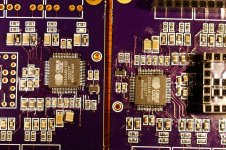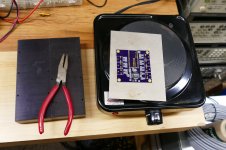I hate work. It interferes with new speakers. I have enough goodies on the shelf to create another 15-20 pairs to add to the masses I have now. Problem is, there is not enough energy in the bod to do both. Once I turned 50, I noticed there is no time in the day where I am not at least a little bit tired.
I need to retire. DIY rules!
Amen.
I need to retire. DIY rules!
Amen.
Its tedious running lots of design error checking on pcb's.
On the last pcb I skipped some of it and of course missed a clearance error !
Shorted power line to GND. My PC got very upset as its a USB device, it gave a warning then shut down the PC. So out with electric drill to drill out a couple of via's and add a wire link.
On the last pcb I skipped some of it and of course missed a clearance error !
Shorted power line to GND. My PC got very upset as its a USB device, it gave a warning then shut down the PC. So out with electric drill to drill out a couple of via's and add a wire link.
I hate work. It interferes with new speakers. I have enough goodies on the shelf to create another 15-20 pairs to add to the masses I have now. Problem is, there is not enough energy in the bod to do both. Once I turned 50, I noticed there is no time in the day where I am not at least a little bit tired.
I need to retire. DIY rules!
Amen.
You and I definately have a lot in common!
Soldering 0.5mm pitch smd TQFP ic's.
First thing is getting it lined up using high power magnifier.
Then blob solder on one side to hold it in place.
Then blob solder on other 3 sides of TQFP package.
Then wick off excess solder.
Buzz out the pins to make sure there are no shorts.
First thing is getting it lined up using high power magnifier.
Then blob solder on one side to hold it in place.
Then blob solder on other 3 sides of TQFP package.
Then wick off excess solder.
Buzz out the pins to make sure there are no shorts.
Accidents. I hate rework.
Actually, what is worse, is knowing that the implementation is not quite right, but barging ahead anyway and hoping the result is acceptable because the rework would be of prohibitively long duration. eg. prohibitive means things like build a new case......and then having an accident because you did not do the right thing and rework it from scratch.
Actually, what is worse, is knowing that the implementation is not quite right, but barging ahead anyway and hoping the result is acceptable because the rework would be of prohibitively long duration. eg. prohibitive means things like build a new case......and then having an accident because you did not do the right thing and rework it from scratch.
Soldering 0.5mm pitch smd TQFP ic's.
I grumbled and cussed away as I soldered my fingers more than the board when I used this method to populate the SMD parts on the first board I made....
Then I remembered the "frying pan" method that I pioneered at Motorola many years ago. It was named for the fact that I actually used a frying pan to "cook up" some of the first boards. The pan has too much thermal mass, so the process evolved into a hot plate, a small piece of aluminum, a big heat sink with a flat surface, some solder paste in a syringe and some tweezers.
The board on the right was made with a soldering iron, solder, tweezers, and an extreme test of patience. It took three days to complete at two or three hour+ long sessions per day.
The board on the left was made in under 3 hours total time yesterday afternoon.
First, using the syringe put a small dab of solder paste on each SMD pad. Run a thin line down each side of the QFP, shorting out all the pins on a side. Depending on the lead pitch this will be about the width of one to two pads.
If you are building several boards, and it is available from the board vendor for a fair price, buy a solder stencil. This allows the whole board to be solder clad with a jar of paste and a squeegee in a few seconds.
Next sit down at the microscope and place each SMD part on the pads in the solder paste. Perfect alignment is not essential if the board was made correctly. The parts should self align when reflowed, except for the IC's. They need to be pretty close, and square with the pads.
Place the board on the aluminum sheet, and turn the hot plate up full. If you have an infrared thermometer, wait until the hot plate is at least 50C hotter than the melting point of your solder, if not, guess. I guessed. Place the aluminum with the board on it on the hot plate such that the board is near the center. Watch until ALL of the solder has reflowed. It will turn from a dull grey to shiny silver. At this point grab the edge of the aluminum with some pliers and CAREFULLY move it to the heat sink to quickly cool it off.
The total "cook time" should be about 1 minute if the hot plate is hot enough. My board was cool enough to handle in about a minute as well, but I have good heat sinks and all surfaces are flat for good contact.
You may have to use some solder wick to remove excess solder from the IC's, but this will be minimal once you learn how much solder to use. The olny touch up I needed on the discrete parts were where I had used parts that were not the correct size for the pads. Total rework time for this board was about 5 minutes.
The solder paste and the hot plate came from Amazon. The solder paste came in a large syringe with a huge needle, bigger than the pads on the board. I ordered a smaller one, which will be here tomorrow. I will try it on my next board.
Attachments
ending up having to order from both digikey and mouser for one project and thereby doubling the duty and taxes... :s
I hate having to wait to fill a shopping cart from any one of them, because I only need $4.34 worth of parts!
Trying to find components and cases in Oz for electronic projects.
And then days later getting a 'foreign transaction fee' from my bank after ordering on Digikey or Mouser..
Trying to find components and cases in Oz for electronic projects. What is also annoying is placing an order with Digikey and when received I've forgotten to order certain items for other projects.
I remember ordering from Maplin electronics in the early 1980's.
You had to fill in an order form and post it off with quantities and order codes. Then a few days later getting the items through with a list of what was out of stock !
Суп на столе - вытри!Lunch, darling! Now!
(Soup's on the table - clean up!)
I have made an oak box for a synth sequencer and I did miss a tenth of a mm here and there when gluing the sh|t together and man, is it hard to ground down ta make it all smooth and perfect.
Oak is like a granite.
(On the other hand spruce or pine get scratches and marks just by looking at it).
- Home
- Member Areas
- The Lounge
- What part of DIY do you HATE?

